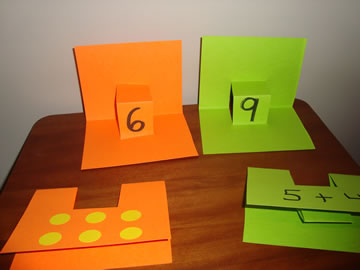

Skills: one-to-one correspondence, counting, sets and numerals, geometry, patterns, addition and subtraction, estimating, measuring
Materials: colored cereal, crackers, or snack mix
Directions: Children can sort, count, graph, add, subtract, make patterns, and then eat the cereal!

Materials: construction paper, school supply catalog, book rings
Directions: Cut out pictures of objects in your classroom (easels, computers, chairs, books, etc.) and glue them to construction paper. Put the pages together to make a book and bind with book rings. Children walk around the room and count the different objects.
Hint! Give children an answer sheet so they can record amounts.

Materials: coupons, scissors
Directions: Bring in the coupons from the Sunday paper and let the children cut them out. Can they sort the coupons by product? Can they sort them by amount?

Materials: zip sandwich bags, paper, pencil, small objects (beans, paper clips, buttons, pretzels, etc.)
Directions: Fill five bags with different amounts of objects. Number the bags from 1-5. Children number their paper and estimate how many objects are in each respective bag. Next, they can empty the bags and count the contents. Did they estimate more? Less?

Materials: breath mint tin, dry lima beans, spray paint
Directions: Spread out lima beans on a sheet of newspaper. Spray paint one side of the beans. Dry. Store the beans in the tin. Children can count the beans, make patterns with the beans, and do addition and subtraction with the beans. *Place 10 beans in the tin. Shake. How many colored beans? How many white beans? How many in all? Shake again and again to discover all the ways to make sets of ten.

Materials: plastic plate divided into 3 sections, counters
Directions: Children make sets in the smaller sections and then join them together in the larger section. How many in all? *Use math plates for missing addend. Put the sum in the largest section. Put the known addend in one of the small sections. What must the missing addend be?


Materials: ice cube tray, cotton balls or other manipulatives
Directions: Children can match objects one to one, make sets, or use for addition and subtraction. *Ice cube trays can also be used for tens and ones. Make tens on the left side and ones on the right side. How many in all?

Materials: construction paper, markers
Directions: Fold the paper in half and cut out footballs, shells, cars, or other seasonal objects on the fold. Draw a set on the front. Open and write the numeral.
*You can also use to reinforce number words and numerals or math facts and the answer.

Materials: five pencil pockets, book rings, sticky notes, flat objects (such as poker chips, craft sticks, feathers, leaves) Directions: Bind the pencil pockets with book rings. Write numerals on sticky notes and tape to each pocket. Children count out the correct number of objects and place them in the pocket.
*Use pockets for sorting objects, addition, money, etc.


Materials: dry lima beans, packaging tape
Directions: Lay a 15” strip of tape sticky side up on a table. Place ten lima beans end to end along the middle of the tape. Bring the top up and the bottom down and seal. Trim off the ends. Use the bean counter like a ruler to measure objects in the classroom.
*Challenge children to find something 1 bean long, 2 beans long, 3 beans, etc.

Materials: deck of cards (remove face cards)
Directions: Children can sort the cards by suit. Next, have them put each suit in numerical order.
*Two children can play “Top It.” Each child draws a card from a shuffled deck. Children place their card face up on the table. The one who “tops it” with the highest number takes both cards. Count to see who has the most at the end. Hint! If both children have the same amount continue drawing until one gets a higher card.

Materials: spiral notebook of index cards
Directions: Write a math fact on the front of each card with a marker. Write the answer on the reverse side with a highlighter. Children can flip through the cards and check their answers.
*Make math flash games with sets and numerals, number words, and other skills you are trying to reinforce.

Materials: plastic bottle, dice, food coloring, glitter
Directions: Put one die in the bottom of each bottle. Fill with water and add a drop of food coloring and a small amount of glitter. Seal lid on with glue. Children shake the bottle and then identify the amount on the bottom. Play with a friend and compare who has more? Less?
*Add two dice to each bottle so children can add. How about three dice? Anyone for four?
Materials: food boxes, colored pencils, paper
Directions: Cut geometric shapes (squares, circles, rectangles, circles, ovals, rhombuses, etc.) out of empty food boxes. Be sure and cut several different sizes of each shape. Children trace around the shapes with colored pencils.
*Challenge children to create objects out of the shapes. A square and triangle can be a tree. A triangle and circle can become an ice cream cone. What else can they make?
